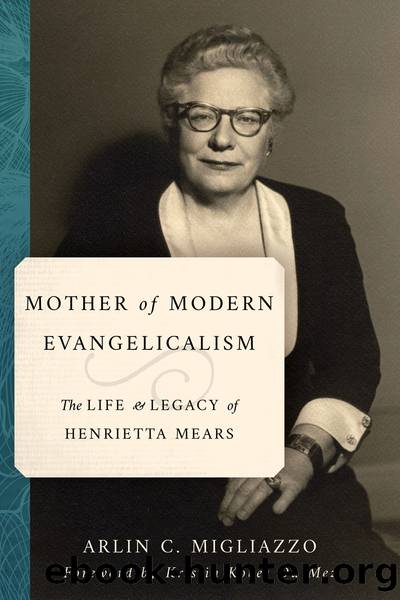Mother of Modern Evangelicalism by Arlin C. Migliazzo

Author:Arlin C. Migliazzo
Language: eng
Format: epub
Publisher: Wm. B. Eerdmans Publishing Co.
Published: 2020-12-15T00:00:00+00:00
Chapter Eight
Teacher and âthe Industryâ
By the time the Mears sisters moved to Southern California, Hollywood had already established itself as the center of the booming entertainment industry. Although the accouterments of celebrity culture were already affecting the population, manners and mores grounded in a deep strain of Protestant theological conservatism flourished alongside the seductive allure of all things Hollywood. Aimee Semple McPhersonâs theatrical style certainly played at spectacle, but other, more traditional institutions parsed the Christian message in a rather less sensational manner. Undoubtedly some members of First Presbyterian shared the sentiments of landlords whose signs indicating âNo Dogs or Actors Allowedâ cluttered the area and looked with jaundiced eye at the metamorphosis of the sleepy village into the unabashed capital of glitz and glitter. After all, the intersection of Gower Street and Sunset Boulevard just four blocks south of the church featured three different studio complexes by 1927. âGower Gulchâ attained further distinction as the spot where would-be cowboy actors congregated, anxiously awaiting casting calls.1
The strides toward respectability taken by the film industry during World War I quickly dissipated in the early 1920s. The Roscoe âFattyâ Arbuckle-Virginia Rappe case was only the most lurid scandal of the era. Less than acceptable behavior off-camera coupled with Hollywoodâs output of postwar films that flouted social norms regarding sexuality, divorce, smoking, and drinking (during Prohibition) âprovoked outrage from womenâs clubs, educators, clergymen, literary societies, newspapers, magazines and other sources.â2 In an attempt to repair the damage, the Motion Picture Producers and Distributors of America hired Presbyterian elder Will Hays to surveil the film industry from the inside. Hays pledged to promote decent entertainment and persuaded the studios to include morality clauses in contracts that allowed them to dismiss those not in compliance. But the jury would remain out as to whether he succeeded in sanitizing an industry that was both loved and reviled.
As film, radio, records, and later television, exerted a progressively broader impact, Mears carried a deep concern for those in the industry. From her earliest days in the Southland she hoped to craft a sustainable Christian witness to the Hollywood set. Because she viewed the entire world as needing salvation, she thought no part of it unredeemable.3 While more than a few of her coreligionists looked with disgust at Hollywood and all it stood for by the late 1920s, Mears wrote that âmy heart ached for this place so far removed from any influence of righteousness or God.â She did not shrink from the hope that Christianity could pervade mass media culture and wanted to be of service to those in the industry who sought to live out their Christian convictions as well as to those who held no religious faith. As one of her associates said, âShe was a friend of show business people. Anyone who had a speck of responsiveness to the Lord, she was in their corner cheeringâ¦. She did not have a whit of judgmentalism in her.â4
Mears could not help but notice that although plenty of
Download
This site does not store any files on its server. We only index and link to content provided by other sites. Please contact the content providers to delete copyright contents if any and email us, we'll remove relevant links or contents immediately.
| Military | Political |
| Presidents & Heads of State | Religious |
| Rich & Famous | Royalty |
| Social Activists |
Waking Up in Heaven: A True Story of Brokenness, Heaven, and Life Again by McVea Crystal & Tresniowski Alex(37040)
Empire of the Sikhs by Patwant Singh(22208)
We're Going to Need More Wine by Gabrielle Union(18112)
Hans Sturm: A Soldier's Odyssey on the Eastern Front by Gordon Williamson(17044)
Leonardo da Vinci by Walter Isaacson(11955)
The Radium Girls by Kate Moore(10947)
Educated by Tara Westover(7096)
Tools of Titans by Timothy Ferriss(7004)
How to Be a Bawse: A Guide to Conquering Life by Lilly Singh(6727)
The Last Black Unicorn by Tiffany Haddish(5095)
Permanent Record by Edward Snowden(5035)
The Rise and Fall of Senator Joe McCarthy by James Cross Giblin(4859)
Promise Me, Dad by Joe Biden(4480)
The Wind in My Hair by Masih Alinejad(4441)
The Crown by Robert Lacey(4127)
A Higher Loyalty: Truth, Lies, and Leadership by James Comey(4061)
The Iron Duke by The Iron Duke(3666)
Joan of Arc by Mary Gordon(3282)
How to be Champion: My Autobiography by Sarah Millican(3202)
